How To Deal With Difficult Customers: Types, Tips, and Examples



When 87% of support teams say customer service expectations have increased in the past year, an elevated customer experience (CX) is more critical than ever to give yourself a competitive advantage.
Maintaining that level of CX can be challenging when encountering difficult customers, but it’s something every company has to deal with.
In this article, you’ll learn about difficult customer types and get nine real-world top tips from the support community to help your customer support team find a positive resolution.
If you ask agents, “What should you do if a customer is being difficult or demanding?” you’ll receive an array of answers. That’s because there’s more than one type of difficult customer.

Source: Glasbergen
Grouping customers into shared traits can make diagnosing their problems and responding appropriately more straightforward. Once reps understand how someone feels, they can implement the right resolution faster.
Here are six common types of difficult customers CS reps may encounter.
Dealing with angry customers can lead to some of the most challenging interactions. It’s natural to become defensive when someone raises their voice or uses harsh language.
However, agents must learn how to handle angry customers and keep their emotions in check. In many cases, agents can take a breath, apologize on behalf of the company, and reroute the conversation in the right direction.
There must also be a clear line between the type of angry behavior your customer support team should politely navigate and the kind that requires escalation to a manager.
How to spot an angry customer: An angry customer may repeatedly interrupt agents, raise their voice, be short with their replies, or demand to speak to a manager.
How to deal with angry customers: Agents should stay calm. It’s ok to place the caller on a brief hold to stay composed and review company guidance on how to handle irate customers. Reps should listen to the issue, ask clarifying questions, display empathy, and then explain how they will solve the problem. If customers become aggressive, company policy should allow reps to move calls to supervisors or politely offer to call back to resolve things at another time.
Demanding or challenging customers have (sometimes unreasonably) high expectations of your product or service and may dictate how they want agents to resolve their issues.
For example, a customer with a faulty product may refuse to show the faulty product on a video call and pressure the agent to send a replacement product regardless. These customers usually have a desired outcome in mind and are happy to disregard rules and policies to achieve it.
Tip: Apizee’s Click-to-Call makes it easy for customers to contact you via a link, button or QR code. Customers get redirected to the first available agent, who appears in their browser with no download required.
How to spot a demanding customer: Demanding customers may be unwilling to listen to alternative solutions. They may also issue ultimatums or even threats in extreme situations in an attempt to get their way.
How to deal with demanding customers: Agents should seek to understand the cause of a demanding customer’s needs to help them effectively. They must also set clear boundaries and manage expectations for anything implausible.
If a customer feels your company isn’t treating them fairly or meeting their needs, their frustration may cause them to lash out. For example, a mad customer may insult your company or make personal comments about an agent.
Even if your company is in the wrong, it’s never acceptable for agents to deal with aggressive or offensive customer interactions. There should be a clear path for how to deal with an unhappy customer when rude comments become personal.
Spotting a rude customer: A rude customer may make hostile comments directed at the company or agent. For instance, personal insults or unfair statements about the service, which may or may not be true.
How to deal with rude customers: Train agents in conflict resolution tactics to defuse the situation, such as acknowledging the customer’s perspective before suggesting alternative solutions. If this doesn’t work, permit them to escalate the interaction to a manager.
An upset customer may be visibly emotional rather than offensive or accusatory. For example, a distressed caller may explain that a recent bereavement led to missed payments.
When dealing with upset customers, the most crucial thing agents can do is handle interactions with a delicate touch and plenty of empathy.
It’s important to note that emotional customers can be quicker to anger if your team doesn’t meet their needs or expectations. However, sometimes this is unavoidable due to company policy or unforeseen circumstances.
How to spot an upset customer: An upset customer may display physical signs of emotion (e.g., flushed cheeks or tears) or you may hear the signs over a phone call, such as wavering speech or shaky breathing. Words and phrases like “This isn’t fair” can also indicate distress.
How to deal with upset customers: Agents should listen to understand why a disgruntled customer is upset. They should then meet the emotion with empathy statements (e.g., “I understand how frustrating this must be”) and kindly discuss possible next steps.
Impatient customers don’t like to wait for resolutions and want agents to meet their demands quickly. For example, a live chat participant may interrupt an agent looking into their issue to demand a progress update.
Agents may begin interactions on the back foot if a queue has kept an impatient customer waiting. Their traits often overlap with demanding customers as both believe their queries should take priority over others.
How to spot an impatient customer: Impatient customers may insist on a speedy resolution for their issue, no matter how complicated. They often reply with short, curt answers and consistently remind agents of their time limit.
How to deal with impatient customers: Ensure agents have the resources they need (e.g., product information, troubleshooting workflows, and call center scripts) to handle queries quickly and efficiently. However straightforward the resolution is, agents should provide regular updates to reassure the customer and keep them informed. Empathy statements can also validate their mindset and make them feel heard.
Indecisive customers can waste agents’ time and decrease productivity. For example, a prospective customer may spend an hour deliberating between two products and asking agents to repeat the benefits of each.
Give reps clear instructions (e.g., spend as much time on each caller as they need or keep calls short to reduce wait time), so they can confidently guide customers through decision-making or alternative solutions.
How to spot an indecisive customer: Indecisive customers don’t know what they need from support reps. They may ask questions or expect agents to lead the conversation.
How to deal with indecisive customers: Agents should ask indecisive customers plenty of questions to narrow down how they can help. They may also suggest sending the customer informational content or connecting them to a sales or product team member to help them decide.
Agents must adjust their responses and make micro-decisions to cater to customers’ individual personalities and queries.
Here are nine tips agents can apply when dealing with difficult customers.
Listening might seem like an obvious thing to do when interacting with customers, but it’s an underrated skill that, when used correctly, can make a huge difference.
Any difficult interaction or customer complaint should start with an explicit focus on listening. This ensures the customer feels heard and agents know what’s happening before suggesting any action.
Active listening can involve demonstrating concern, asking questions, and using brief verbal affirmations (e.g., “Mhm”).
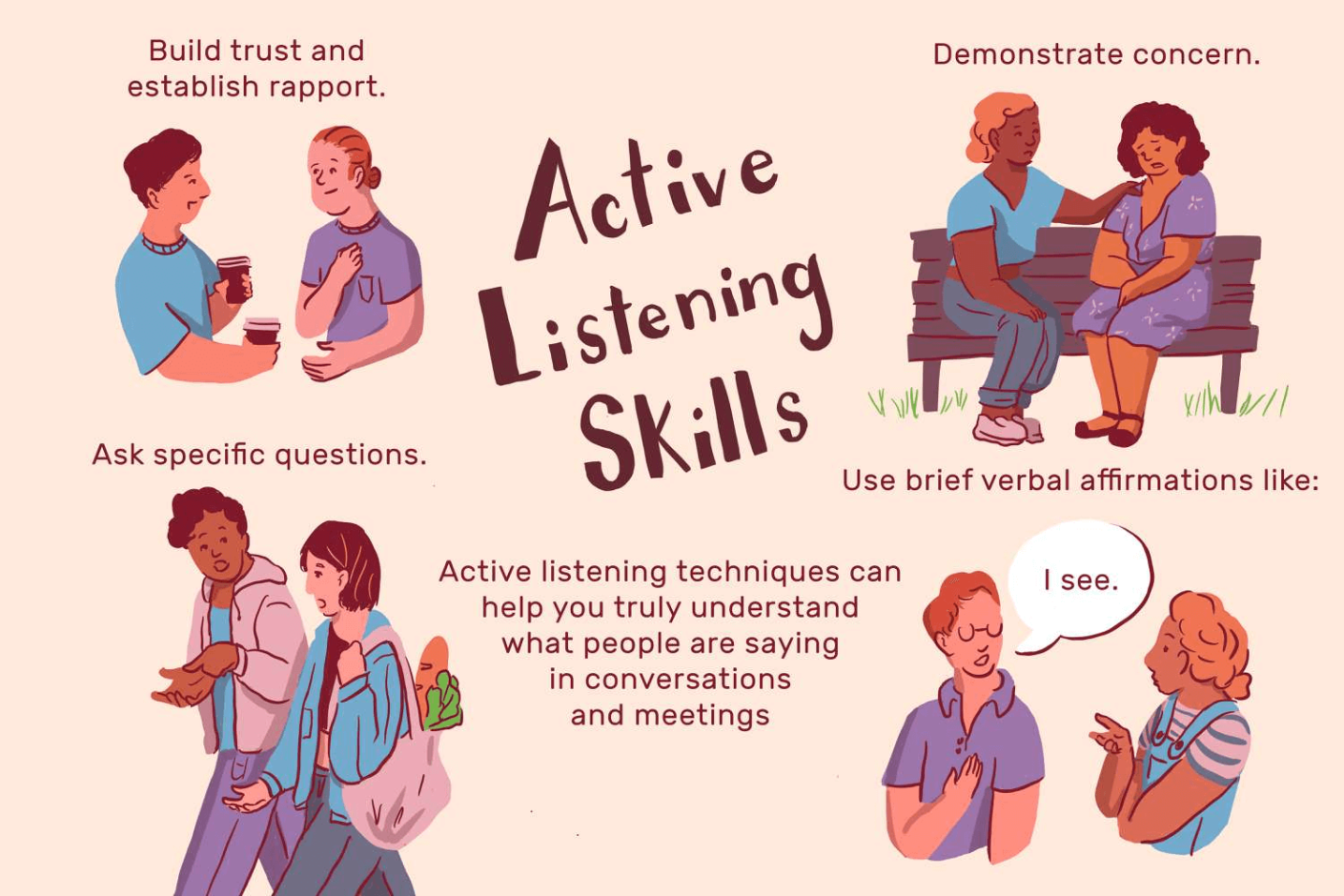
Source: The Balance
Difficult customers will likely also pick up on errors or inconsistencies, no matter how small. Accurately hearing the facts and the customer’s perspective is crucial to mitigate this.
Let’s say a customer opens a call with a remark about the wait time. They’re frustrated about how long they spent on hold and vent about the poor customer service. Then, they detail an ongoing billing discrepancy where none of the self-service options resolved their problem.
If the agent doesn’t listen to each of the customer’s steps, suggesting something they’ve already tried may rile them further.
“Listening attentively shows respect and genuine interest in the customer. It helps create a connection and establishes trust, which is vital in building long-term relationships. Customers are more likely to buy from someone they trust and feel understands their unique circumstances.”
With a full and complete understanding of the problem, the agent can respond by:
When the rep dominates the interaction or doesn’t listen to the entire situation, it’s difficult to understand the real issue and reach a satisfactory resolution.
Instead, pinpoint what each person wants to achieve (along with solutions they’ve already tried) in order to understand the cause and resolve the issue faster.
Establish company-wide policies during onboarding and training so employees know how to handle different types of callers.
According to Genesys research, inconsistent expectations are among employees’ top complaints about working in contact centers. Reps need to feel confident knowing when they should offer refunds, offer discounts on other products, or escalate to a manager.
Let’s say an agent has been on a video chat with a customer for well over the average call time. They’ve exhausted all options for solving the issue today and have to wait for an in-person callout.
The customer refuses to end the interaction, demanding an immediate resolution. However, the agent knows that company protocol dictates they offer the customer one last walkthrough of their options.
In this case, the agent can refer to the company’s knowledge base and explain the process.
For example, “I’m sorry we can’t fix your software remotely. As I’ve said, we’ll send an engineer out in two working days to sort it. Would you like me to walk through your options again, or would you prefer to take some time to think about them and get in touch later?”
Set employee expectations like these upfront and make them available in an easily searchable database (e.g., Talkdesk). Regularly remind employees of your protocols and keep them updated with current best practices.
On creating customer service policies, award-winning author and global speaker Richie Norton warns:
“Policy and procedures create 80% of problems at work. Choose wisely.”
If you’re in charge of creating the policy, ensure you’ve collated the best practices from the industry and then balance them with the limits of what your company expects from employees.
If you need to make a case for a policy update from your superiors, gather data and metrics to support your push for better procedures (e.g., employee churn metrics, the number of calls lasting 30 minutes or more, etc.).
Companies should establish policies that dictate when enough is enough during heated interactions.
If an abusive customer is outside the acceptable scope of anger or upset, you may permit agents to reconnect at a better time when temperatures have cooled.
Hold your customer experience on a pedestal, but not at the expense of your employees. No one deserves to be degraded or insulted for doing their job.
Organize in-depth training for agents to become knowledgeable in the product and users they support.
According to an OpinionWay survey, 72% of French consumers cite an agent’s inability to understand their query as part of a bad CS experience. Training allows reps to handle various issues on their own.
Genesys research also suggests learning new technologies is the most enjoyable part of European contact center employees’ jobs.

Instead of viewing product training as a chore, you can position it as an opportunity to upskill and reduce the stress of challenging interactions.
Let’s say a customer has noticed that they can’t generate accurate tax reports after updating their operating system. Reps who understand the product like experts can provide clear, detailed directions for customers to resolve the issue quickly.
If you have targets to increase customer experience metrics like first contact resolution (FCR), Net Promoter Score (NPS), and customer satisfaction (CSAT) score, increasing your reps’ product knowledge can help.
Tip: You can work out your current FCR rate and Net Promoter Score with our handy calculators.
CS and CX consultant Parker Chase-Corwin thinks that internal product enablement should happen before public release to allow teams to confidently handle any questions:
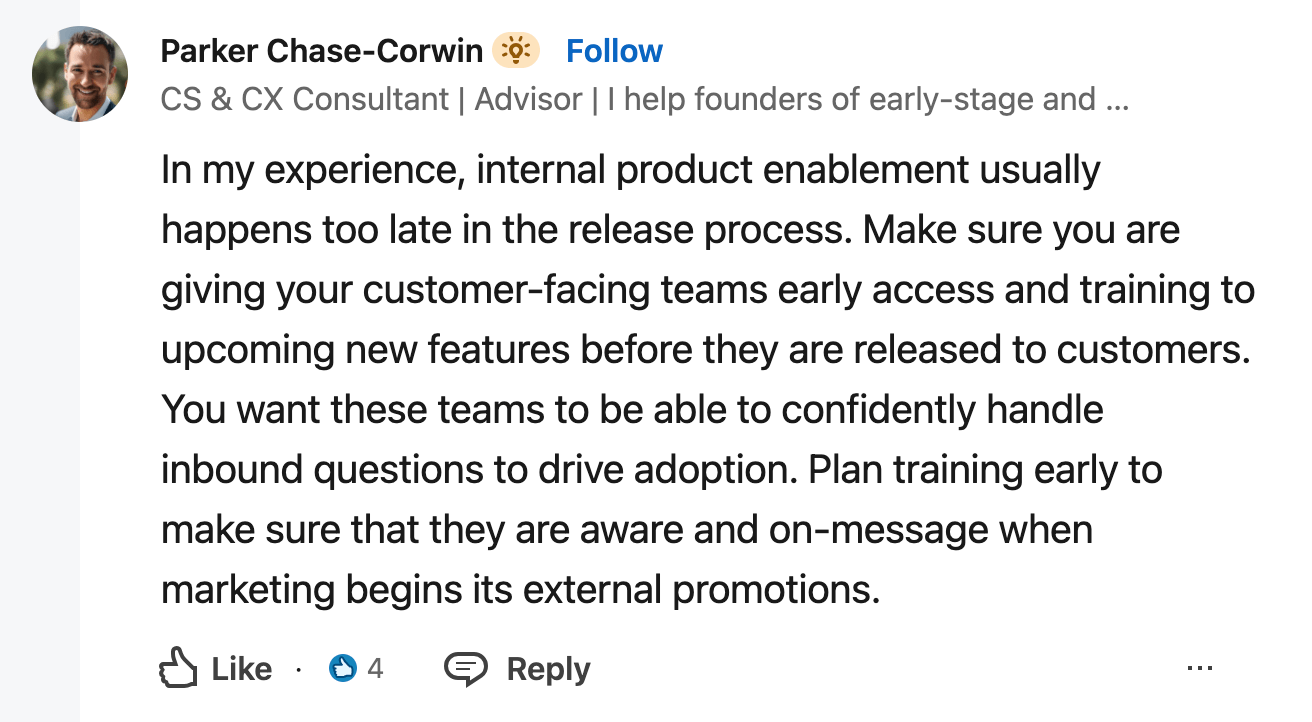
Connect new team members with the product team during onboarding and arrange time for agents to explore the product like users. After that, stay informed of any product updates and how these might impact customers so you can inform your team accordingly.
No matter how difficult the customer is, agents must stay calm to avoid worsening a tense situation. For some, patience comes naturally. For others, this may require training.
Let’s say a rep is on the phone with an angry customer who’s unhappy with product quality. The rep takes a deep breath and counts to three before responding. This calms their nervous system and gives them time for any defensive feelings to pass.
The agent then meets the customer’s shouting with a measured tone. If the caller won’t let the agent respond, they stay silent. This allows the customer to get their frustrations out of their system, which can sometimes be enough to defuse their heightened emotions.
Note: Disarming difficult customers with silence can be helpful in more extreme situations. Providing space to unravel thoughts can help customers calm down. However, it’s a delicate balance as too much silence can induce more frustration.
According to customer service officer Eva Fernandez, staying composed is crucial for working towards a resolution:

Agents can also respond to angry or frustrated customers with calming statements like:
Organize agent training to promote softer skills like de-escalation and problem-solving. You can arrange in-person workshops, online courses, or both to strengthen your team’s conflict-resolution abilities.
When taking over from another team member, ensure agents have all the context of prior interactions so they don’t need to get it from an already angry or upset customer.
For almost 53% of customers, repeating problems multiple times is one of the top annoyances about interacting with customer service departments.
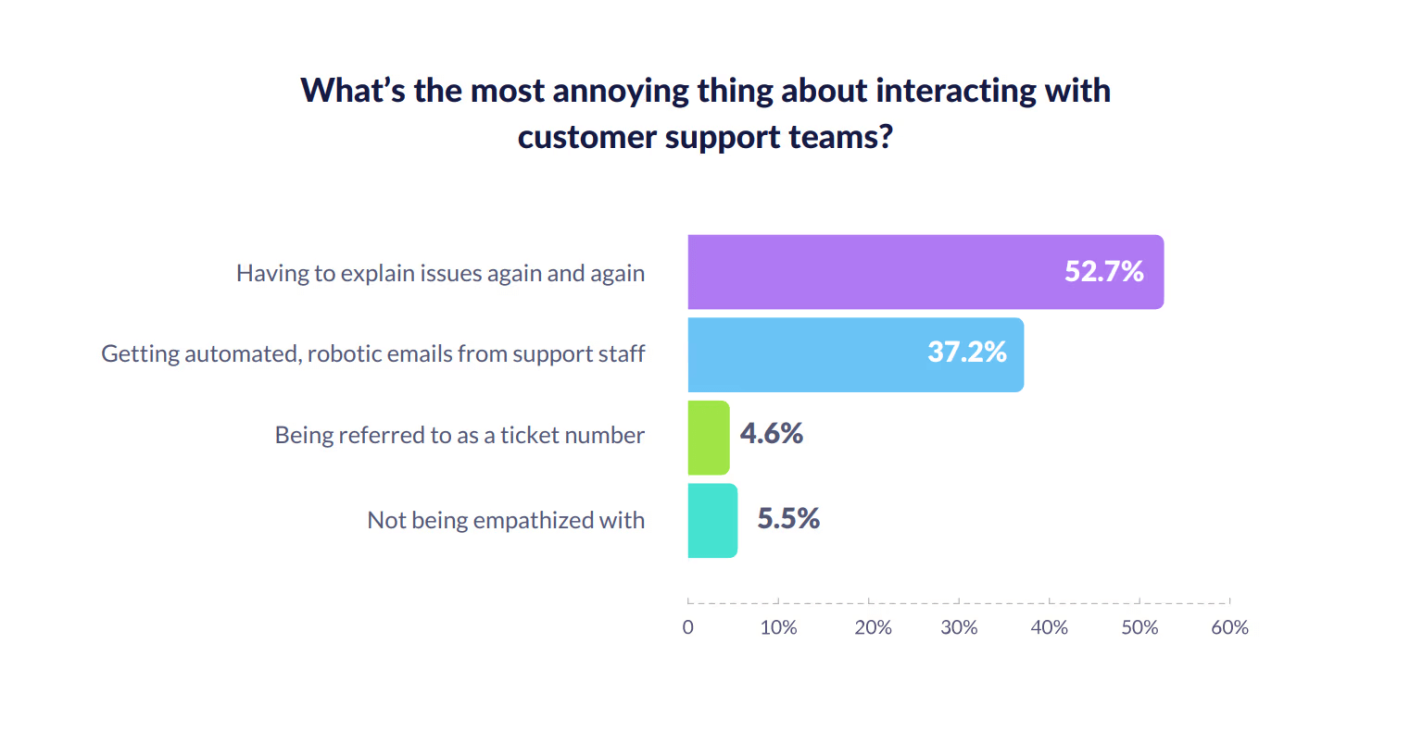
Imagine a customer starts by explaining their issue to a chatbot. When it can’t help, it escalates the conversation to a human rep who passes the chat to a more qualified engineer.
Tip: Learn how chatbot vs. human support compares and when to implement both types best.
By the time the engineer has started a video chat to discuss the problem in more detail, the customer has repeated the problem four times and is increasingly frustrated. A previously calm customer could become impatient or demanding.
There are plenty of tools that can help contact centers avoid having customers repeat information. Implementing an omnichannel contact center, for example, seamlessly connects all communication channels and technology.
A live chat, for example, can quickly and easily be upgraded to a video call with a simple link. If one team member can’t help, they can pass everything to another who also has the full rundown. This workflow keeps the customer at the heart of interactions and minimizes their effort to keep them happier.
Reducing time spent gathering the same information not only prevents angry customers, it can also save the company money. According to renowned customer service and experience expert Shep Hyken:
“It is a waste of time for the support representative to have to listen to a story that’s already been told. And if time is money, and it is, then that wasted time over a number of calls, can add up to a big number. So stop wasting both your and your customer’s time. It will save you money and give your customer a better experience.”
Connect your communication channels and make information handoff easier to save your customers from an unpleasant experience and your company from wasted resources.
Sometimes, switching the interaction’s platform can change everything. Because live chat and calls are visual barriers, customers may feel they can get away with speaking in a way they wouldn’t in person.
Customers can adopt some of this anonymity and mindset on specific platforms (e.g., social media messages). But as soon as agents put them face-to-face with another human, they’re less likely to continue this behavior.
Imagine an agent has the ability to switch from a live chat where the customer’s temper is rising to a video chat.
When both parties can see each other, it humanizes the agent to the customer, which can soften their temperament. It also makes the conversation feel more personalized, with one human speaking to another — not a faceless company or chatbot.
Visual engagement tools (e.g., video chat, screen sharing, and co-browsing) can make this scenario a reality to solve complex customer problems more efficiently.
Apizee’s solutions can help agents humanize interactions and pacify difficult customers with visual cues, gestures, body language, and eye contact (if the customer also has their camera on).
Here’s how it works:
According to My Living Bloom digital landscaper designer Maxime Corbière:
“The benefits of video are above all the conviviality of the exchange that we establish with the customer. It also saves time for the customer, who doesn’t have to wait for a craftsman to come to his home, and it saves time for us to collect all the information, such as photos, work areas and the materials envisaged.”
Use Apizee’s visual engagement tools to offer personalized interactions that positively impact customer loyalty and your bottom line.
Add video chat to create personalized experience while resolving problems faster.
Get a demo
Empathy helps agents better understand and communicate with customers to improve the quality of interactions (especially challenging ones).
According to Verywell mind, there are three different types of empathy:

Emotionally intelligent agents can use all three types to understand a difficult customer’s mind and adjust their responses appropriately.
It’s a crucial customer service skill when Genesys research also suggests that consumers value empathy more than resolution speed.
However, as customer service consultant Micah Solomon clarifies, it’s about reading customer cues and figuring out what they value:
“Perhaps the most fundamental empathy-building skill that customer service empathy training needs to convey is to pick up on — and appropriately respond to — cues from your customer. But not just any cues.
Hearing a customer’s dog bark and saying, “Oh, Ms. X, I love dogs too! What breed of dog do you have?” is fine but not next-level. The big wins come when you focus on cues that hold significance to the customer.”
Imagine an upset customer calls because she’s missed several payments, and the system has canceled her regular order. She’s audibly distressed as she explains she accidentally deleted her direct debit and won’t be able to trade this weekend without stock.
An empathetic agent first acknowledges the customer’s distress and validates her feelings. Then, the agent reassures the customer that they understand the situation’s urgency and suggests a proactive next-day delivery.
The agent may say, “Missing payments can happen to anyone. I understand how stressful that can be. Let’s explore options to reinstate your regular order and ensure you have the stock you need for the weekend.”
Other examples of empathy statements include:
Some customers dislike it when agents bring personal examples into the conversation, but it can work to humanize them too. The rest of the interaction with the customer will influence if it’s appropriate. For instance, it might create a connection with an indecisive customer but may aggravate a rude customer.
Empathetic tactics can also mirror the customer’s cues and make them more comfortable. For example, if a customer uses more formal language, refer to them as “Mr. Black” rather than “Tom.”
If agents can’t find a same-day resolution, leave the customer with a clear plan so they don’t feel your company has wasted their time.
Let’s say a customer has been dealing with an ongoing technical issue with their project management software that an agent has been trying to fix. The conversation progresses from a call to a co-browsing session, in which both parties interact with the same screen.
The agent is a product expert trying to determine what’s preventing the user from assigning tasks to certain team members. The agent tries every fix they can think of before saying there must be a system glitch.
The engineering team is busy, but the agent doesn’t want to waste more of the customer’s time. They promise they’ll chase until they hear back and email the customer by the end of the day, regardless.
When speaking to a disgruntled customer about a delayed resolution, agents should walk through a clear roadmap to ensure no miscommunication. This roadmap should include:
While sales reps communicate the next steps directly, Harvard Business Review authors Rebecca Hinds and Sarang Gupta state that customer experience is the entire company’s responsibility:
“In our research, we’ve found that standout customer experiences are fueled by new, cross-functional collaborations across organizations. Customer experience can no longer be driven by the frontline sales representative or even a dedicated customer experience team — everyone in your organization has a role to play.”
Whoever deals with the outcome, it’s also crucial your company follows through with the outlined steps to convey reliability and build stronger customer relationships.
Sometimes, even your toughest employees can struggle to deal with the mental load of difficult customers.
Suppose someone continually uses inappropriate or abusive language. In that case, agents should know when to escalate the interaction to a team member or manager with more experience and authority.
Imagine a customer is unhappy with your company’s returns policy. The agent explains that too much time has passed to accept a return so instead offers a discounted price for another product.
When the customer escalates to inappropriate language, the agent puts them on hold and messages their manager with the screenshot. The manager takes over, repeats the agent’s response, and politely asks the customer to get back in touch if they want to order the discounted alternative.
Be clear about when it’s appropriate to ask for help and follow through with this policy. Unnecessarily escalated conversations can decrease team productivity and create friction in your CX.
Training is essential here. Ensure your agents know what classifies as an “escalatable situation” (via those protocols we mentioned earlier). Customer service excellence trainer Lionel Dawaii agrees that situations can be very subjective:
“Sometimes not all ‘difficult’ situations are difficult, at times internal factors can make the interaction difficult.”
To ensure agents understand the differentiator, implement role-play exercises in which the agents play the part of the customer. You can also arrange training sessions where everyone analyzes recorded escalated calls so agents learn when to use this lifeline correctly.
Most customers aren’t angry when they begin the support process. So, how do they get to this stage?
Gladly found that 73% of consumers don’t want businesses to treat them like a case number. But support processes can make them feel this way without human, personalized processes to avoid it.
Support wait times (one of the leading causes of customer irritation) vary between industries.

Source: Thebusystories
For example, the average wait time to speak to a UK energy company (one of the worst offenders) is around 35 minutes and 34 seconds.
In comparison, telecommunications providers sit at around 2 minutes and 3 seconds.
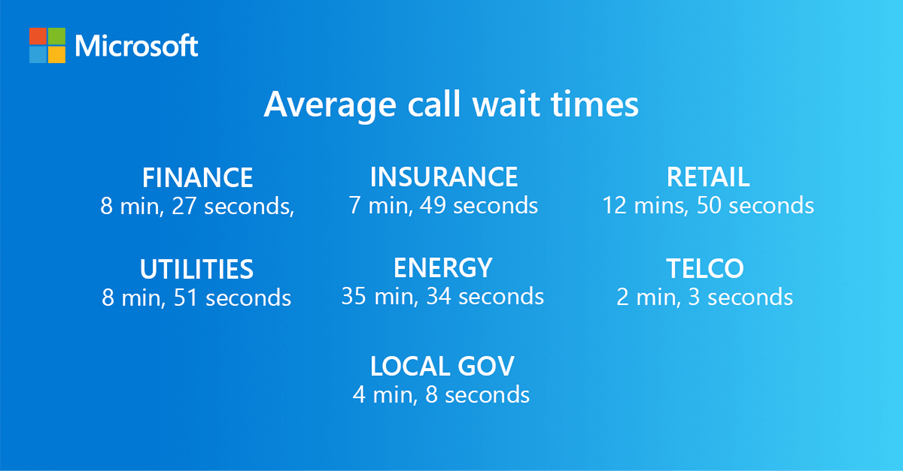
Thanks to this stark difference, you may have to deal with customers in your industry who have different expectations from dealing with another business or industry.
The maximum wait time paints an even bleaker picture for customers hoping for speedy resolutions. In this case, energy providers can make customers wait up to one hour and 25 minutes — equivalent to listening to Queen’s Bohemian Rhapsody 14 times.
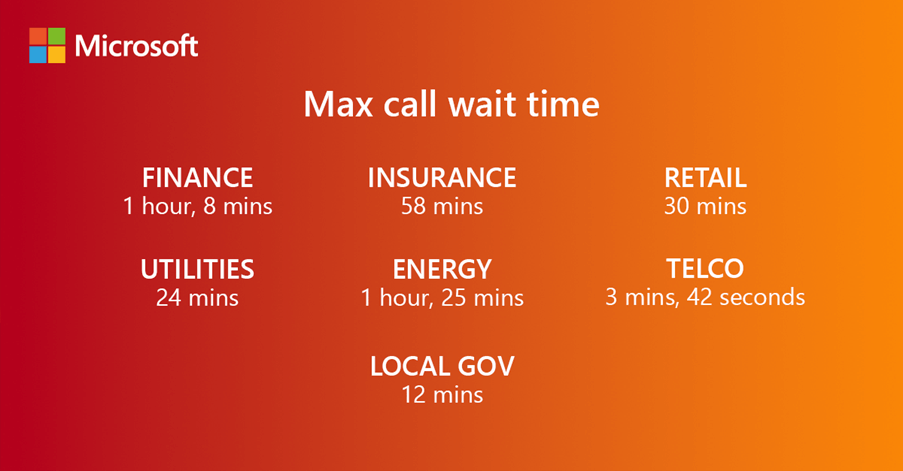
Though some customers may present consistent challenges, common customer irritants can temporarily create a difficult mentality for others.
Here are five of the most common and how to fix them:
| Customer irritant | How to fix it |
|---|---|
| Being left on hold for too long |
•Implement a call-back service • Use a chatbot for initial information gathering • Hire more agents |
| Repeating the same issue multiple times | • Become an omnichannel contact center |
| Being unable to switch between communication channels | • Become an omnichannel contact center |
| Companies not following through on promises |
• Set company-wide next steps for follow-ups • Use automation to streamline after-call processes |
| Not getting a solution on the first call | • Train agents to become product experts so they can handle a broader range of queries |
Implementing these solutions can turn even the most difficult people into loyal customers.
Despite the popular phrase, customers may not always be right. However, agents can learn how to handle difficult customers through active listening, courtesy, composing themselves before responding, and patience.
Great customer service isn’t just about solving interactions during the first call (although it helps). It’s also about making customers feel heard and swiftly making things right when you get them wrong.
Apizee can give your team the visual tools to de-escalate challenging situations and keep difficult customers happier with humanized interactions.
Get a demoVideo KYC streamlines compliance, reduces fraud, and improves onboarding for financial institutions. Learn four steps to implement it successfully in 2026.
Video KYC in 2026: How It’s Evolving and 4 Steps to Implement It
17 Oct 2025
Explore the evolution of computer vision, its modern applications, and the future of AI-powered visual intelligence across industries.
From Early Experiments to Modern AI: The Evolution of Computer Vision
13 Oct 2025
Celebrate CX Day with purpose. Discover what CX Day is, upcoming dates, 10 ways to celebrate, and top influencers shaping customer experience.
What Is CX Day and How to Celebrate
7 Oct 2025
Interested in our solutions?